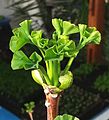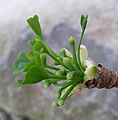Ginkgo biloba
| Ginkgo biloba | |
|---|---|
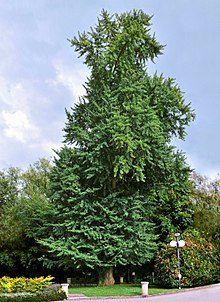
| |
| Scientific classification | |
| Kingdom: | Plantae |
| Clade: | Tracheophytes |
| Clade: | Gymnospermae |
| Division: | Ginkgophyta |
| Class: | Ginkgoopsida |
| Order: | Ginkgoales |
| Family: | Ginkgoaceae |
| Genus: | Ginkgo |
| Species: | G. biloba
|
| Binomial name | |
| Ginkgo biloba | |
| Synonyms[4] | |
| |
Ginkgo biloba, commonly known as ginkgo or gingko (/ˈɡɪŋkoʊ, ˈɡɪŋkɡoʊ/ GINK-oh, -goh),[5][6] also known as the maidenhair tree,[7] is a species of gymnosperm tree native to East Asia. It is the last living species in the order Ginkgoales, which first appeared over 290 million years ago, and fossils very similar to the living species, belonging to the genus Ginkgo, extend back to the Middle Jurassic epoch approximately 170 million years ago.[2] The tree was cultivated early in human history and remains commonly planted, and is widely regarded as a living fossil.
Ginkgo leaf extract is commonly used as a dietary supplement, but there is insufficient clinical evidence that it supports human health or is effective against any disease.[8][9]
Etymology
The genus name is regarded as a misspelling of the
Despite its spelling, which is due to a complicated etymology including a transcription error, "ginkgo" is usually pronounced /ˈɡɪŋkoʊ/, which has given rise to the common alternative spelling "gingko". The spelling pronunciation /ˈɡɪŋkɡoʊ/ is also documented in some dictionaries.[12][13]
Engelbert Kaempfer first introduced the spelling ginkgo in his book Amoenitatum Exoticarum. It is considered that he may have misspelled "Ginkjo" or "Ginkio" (both consistent with his treatment of Japanese kyo in the same work) as "Ginkgo". This misspelling was included by Carl Linnaeus in his book Mantissa plantarum II[14] and has become the name of the tree's genus.[15][12] The specific epithet biloba is New Latin for "two-lobed".
Description
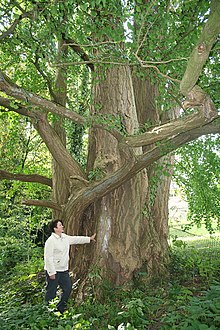
Ginkgos are large trees, normally reaching a height of 20–35 m (66–115 ft),[16] with some specimens in China being over 50 m (165 ft). The tree has an angular crown and long, somewhat erratic branches, and is usually deep-rooted and resistant to wind and snow damage. Young trees are often tall and slender, and sparsely branched; the crown becomes broader as the tree ages. A combination of resistance to disease, insect-resistant wood, and the ability to form aerial roots and sprouts makes ginkgos durable, with some specimens claimed to be more than 2,500 years old.[17]
Leaves


The
Leaves of long shoots are usually notched or lobed, but only from the outer surface, between the veins. They are borne both on the more rapidly growing branch tips, where they are alternate and spaced out, and also on the short, stubby spur shoots, where they are clustered at the tips. Leaves are green both on the top and bottom[20] and have stomata on both sides.[21] During autumn, the leaves turn a bright yellow and then fall, sometimes within a short space of time (one to fifteen days).[22]
Branches
Ginkgo branches grow in length by growth of shoots with regularly spaced leaves, as seen on most trees. From the
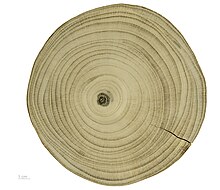
Ginkgo prefers full sun and grows best in environments that are well-watered and well-drained. The species shows a preference for disturbed sites; in the "semiwild" stands at Tianmu Mountains, many specimens are found along stream banks, rocky slopes, and cliff edges. Accordingly, ginkgo retains a prodigious capacity for vegetative growth. It is capable of sprouting from embedded buds near the base of the trunk (lignotubers, or basal chichi) in response to disturbances, such as soil erosion. Old specimens are also capable of producing aerial roots on the undersides of large branches in response to disturbances such as crown damage; these roots can lead to successful clonal reproduction upon contacting the soil. These strategies are evidently important in the persistence of ginkgo; in a survey of the "semiwild" stands remaining in Tianmushan, 40% of the specimens surveyed were multi-stemmed, and few saplings were present.[23]: 86–87
Reproduction
Ginkgo biloba is
Female plants do not produce cones. Two
The fertilization of ginkgo seeds occurs via
Genome
Chinese scientists published a draft genome of Ginkgo biloba in 2016.[32] The tree has a large genome of 10.6 billion DNA nucleobase "letters" (the human genome has three billion) and about 41,840 predicted genes[33] which enable a considerable number of antibacterial and chemical defense mechanisms.[32] 76.58% of the assembled sequence turned out to be repetitive sequences.[34]
In 2020, a study in China of ginkgo trees up to 667 years old showed little effects of aging, finding that the trees continued to grow with age and displayed no genetic evidence of senescence, and continued to make phytochemicals indefinitely.[35]
Phytochemicals
Extracts of ginkgo leaves contain
Taxonomy
The older Chinese name for this plant is 銀果, meaning "silver fruit", pronounced yínguǒ in Mandarin or Ngan-gwo in Cantonese. The current commonly used names are 白果 (bái guǒ), meaning "white fruit", and 銀杏 (yínxìng), meaning "silver apricot". The name 銀杏 was translated into Japanese as イチョウ (ichou) or ぎんなん (ginnan) and into Korean as 은행 (eunhaeng).
The scientific name Ginkgo is the result of a spelling error that occurred three centuries ago. Kanji typically have multiple pronunciations in Japanese, and the characters 銀杏 used for ginnan can also be pronounced ginkyō. Engelbert Kaempfer, the first Westerner to investigate the species in 1690, wrote down this pronunciation in the notes that he later used for the Amoenitates Exoticae (1712) with the "awkward" spelling "ginkgo".[40] This appears to be a simple error of Kaempfer; taking his spelling of other Japanese words containing the syllable "kyō" into account, a more precise romanization following his writing habits would have been "ginkio" or "ginkjo".[15] Linnaeus, who relied on Kaempfer when dealing with Japanese plants, adopted the spelling given in Kaempfer's "Flora Japonica" (Amoenitates Exoticae, p. 811). Kaempfer's drawing can be found in Hori's article.[11]
Classification
The relationship of ginkgo to other plant groups remains uncertain. It has been placed loosely in the divisions
The ginkgo is classified in its own
-
Extinct Ginkgo yimaensis[43]
-
Extinct Ginkgo apodes[43]
-
Extant Ginkgo biloba[43]
Evolution

Ginkgo biloba is a
sperm.Such plants with leaves that have more than four veins per segment have customarily been assigned to the taxon Ginkgo, while the taxon Baiera is used to classify those with fewer than four veins per segment. Sphenobaiera has been used for plants with a broadly wedge-shaped leaf that lacks a distinct leaf stem.[citation needed]
Rise and decline

Fossils attributable to the genus Ginkgo first appeared in the Middle Jurassic. The genus Ginkgo diversified and spread throughout Laurasia during the Jurassic and Early Cretaceous.[44]
The Ginkgophyta declined in diversity as the Cretaceous progressed, and by the Paleocene, Ginkgo adiantoides was the only Ginkgo species left in the Northern Hemisphere, while a markedly different (and poorly documented) form persisted in the Southern Hemisphere. Along with that of ferns, cycads, and cycadeoids, the species diversity in the genus Ginkgo drops through the Cretaceous, at the same time the flowering plants were on the rise; this supports the hypothesis that, over time, flowering plants with better adaptations to disturbance displaced Ginkgo and its associates.[23]: 93
At the end of the Pliocene, Ginkgo fossils disappeared from the fossil record everywhere except in a small area of central China, where the modern species survived.
Limited number of species
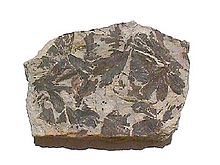
It is doubtful whether the Northern Hemisphere fossil species of Ginkgo can be reliably distinguished. Given the slow pace of evolution and morphological similarity between members of the genus, there may have been only one or two species existing in the Northern Hemisphere through the entirety of the Cenozoic: present-day G. biloba (including G. adiantoides) and G. gardneri from the Paleocene of Scotland.[23]: 85
At least morphologically, G. gardneri and the Southern Hemisphere species are the only known post-Jurassic taxa that can be unequivocally recognised. The remainder may have been ecotypes or subspecies. The implications would be that G. biloba had occurred over an extremely wide range, had remarkable genetic flexibility and, though evolving genetically, never showed much speciation.[citation needed]
While it may seem improbable that a single species may exist as a contiguous entity for many millions of years, many of the ginkgo's life-history parameters fit: Extreme longevity; slow reproduction rate; (in Cenozoic and later times) a wide, apparently contiguous, but steadily contracting distribution; and (as far as can be demonstrated from the fossil record) extreme ecological conservatism (restriction to disturbed streamside environments).[23]: 91
Adaptation to a single environment
Given the slow rate of evolution of the genus, Ginkgo possibly represents a pre-
Modern-day G. biloba grows best in environments that are well-watered and drained,[23]: 87 and the extremely similar fossil Ginkgo favored similar environments: The sediment record at the majority of fossil Ginkgo localities indicates it grew primarily in disturbed environments, such as along streams.[23] Ginkgo, therefore, presents an "ecological paradox" because while it possesses some favorable traits for living in disturbed environments (clonal reproduction) many of its other life-history traits are the opposite of those exhibited by modern plants that thrive in disturbed settings (slow growth, large seed size, late reproductive maturity).[23]: 92
Distribution and habitat
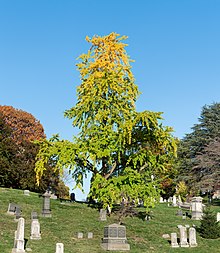
Although Ginkgo biloba and other species of the genus were once widespread throughout the world, its habitat had shrunk by two million years ago.
For centuries, it was thought to be extinct in the wild,[45] but is now a common tree cultivated throughout eastern China, Korea, and Japan. Many municipalities in Korea and Japan use Ginkgos as street trees, and Ginkgo leaves are the emblem of prominent educational institutions such as the University of Tokyo and Sungkyunkwan University in South Korea. Despite their widespread habitat, high genetic uniformity exists among ginkgo trees, with some Chinese scholars suggesting that ginkgo trees in these areas may have been planted and preserved by Chinese monks over about 1,000 years.[46] This study demonstrates a greater genetic diversity in Southwestern China populations, supporting glacial refugia in mountains surrounding the eastern Tibetan Plateau, where several old-growth candidates for wild populations have been reported.[46][47] Recently, the findings of Ginkgo trees aged 1,500 years in Samcheok-si, Korea (the Neukguri Ginkgo, designated as Korea's natural artifact in 1986),[48] and aged 1,200 in Tsurugaoka Hachimangu Shrine in Japan have discredited theories claiming Chinese origins of Ginkgo.[citation needed] Whether native ginkgo populations still exist has not been demonstrated unequivocally, but there is genetic evidence that these Southwestern populations may be wild, as well as evidence that the largest and oldest Ginkgo biloba trees may be older than surrounding human settlements.[46]
Where it occurs in the wild, Ginkgo is found infrequently in deciduous forests and valleys on acidic loess (i.e. fine, silty soil) with good drainage. The soil it inhabits is typically in the pH range of 5.0 to 5.5.[49]
Cultivation
Ginkgo has long been cultivated in China. It is common in the southern third of the country.[49] Some planted trees at temples are believed to be over 1,500 years old. The first record of Europeans encountering it is in 1690 in Japanese temple gardens, where the tree was seen by the German botanist Engelbert Kaempfer. Because of its status in Buddhism and Confucianism, the ginkgo has also been widely planted in Korea and in Japan since the 14th century;[50] in both areas, some naturalization has occurred, with ginkgos seeding into natural forests. Ginkgo has been commonly cultivated in North America for over 200 years and in Europe for close to 300, but during that time, it has never become significantly naturalized.[51]
G. biloba is also commonly manually planted in cities across the United States and Europe. This species is highly tolerant to pollution and serves as a visually appealing, shade-providing tree in many cities and gardens.[52]
Many intentionally planted ginkgos are male cultivars grafted onto plants propagated from seed, because the male trees will not produce the malodorous seeds. The popular cultivar 'Autumn Gold' is a clone of a male plant.[citation needed]
The disadvantage of male Ginkgo biloba trees is that they are highly allergenic. They have an OPALS (Ogren Plant Allergy Scale) rating of 7 (out of 10), whereas female trees, which can produce no pollen, have an OPALS allergy scale rating of 2.[53]
Female cultivars include 'Liberty Splendor', 'Santa Cruz', and 'Golden Girl', the latter so named because of the striking yellow color of its leaves in the fall; all female cultivars release zero pollen.[53]
Many cultivars are listed in the literature in the
Ginkgos adapt well to the urban environment, tolerating pollution and confined soil spaces.[56] They rarely have disease problems, even in urban conditions, and are attacked by few insects.[57][58]
Ginkgos are popular subjects for growing as miniature landscapes known as penjing and bonsai;[59] they can be kept artificially small and tended over centuries. The trees are easy to propagate from seed.
Hiroshima
Extreme examples of the ginkgo's tenacity may be seen in Hiroshima, Japan, where six trees growing between 1 and 2 kilometres (1⁄2 and 1+1⁄4 miles) from the 1945 atom bomb explosion were among the few living organisms in the area to survive the blast. Although almost all other plants (and animals) in the area were killed, the ginkgos, though charred, survived and were soon healthy again, among other hibakujumoku (trees that survived the blast).[citation needed]
The six trees are still alive: They are marked with signs at Housenbou (報専坊) temple (planted in 1850), Shukkei-en (planted about 1740), Jōsei-ji (planted 1900), at the former site of Senda Elementary School near Miyukibashi, at the Myōjōin temple, and an Edo period-cutting at Anraku-ji temple.[60]
1000-year-old ginkgo at Tsurugaoka Hachimangū

At the
Modern scholarship has established that ginkgos arrived from China in the 14th century, and a 1990 tree-ring measurement indicated the kakure-ichō's age to be about 500 years.[11]
On 10 March 2010, the tree blew down in a storm, but the stump has since sprouted vigorously.[61]
1,400-year-old ginkgo tree at Gu Guanyin
The grounds of the Buddhist temple at Gu Guanyin in the Zhongnan Mountains feature a ginkgo tree reputed to be 1,400 years old.[62][63] The tree itself is a popular tourist attraction.
Uses
The wood of Ginkgo biloba is used to make furniture, chessboards, carving, and casks for making
Culinary



The nut-like kernels of the seeds are particularly esteemed in Asia, and are a traditional ingredient in Chinese food. Ginkgo nuts are used in congee, and are often served at special occasions such as weddings and the Chinese New Year (as part of the vegetarian dish called Buddha's delight). Japanese cooks add ginkgo seeds (called ginnan) to dishes such as chawanmushi, and cooked seeds are often eaten along with other dishes. Grilled ginkgo nuts with salt are also a popular item at izakayas as a healthy snack with beer and other Japanese food.[64] In Korea, ginkgo nuts are stir-fried and eaten, or are used to garnish foods such as sinseonro.[65]
When eaten in large quantities or over a long period, the seeds may cause poisoning by ginkgotoxin (4'-O-methylpyridoxine, MPN), as found in a few case reports.[66][67] A heat-stable compound not destroyed by cooking, MPN may cause convulsions, which were alleviated by treatment with pyridoxine phosphate (vitamin B6), according to limited studies.[66][67]
Some people are sensitive to the chemicals in the sarcotesta, the outer fleshy coating. These people should handle the seeds with care when preparing the seeds for consumption, wearing disposable gloves. The symptoms are allergic contact dermatitis,[68][69] or blisters similar to that caused by contact with poison ivy.[70]
Medical research
Although
There is weak preliminary evidence for ginkgo affecting dementia[78][79][80] and tardive dyskinesia symptoms in people with schizophrenia.[81]
Adverse effects
According to a
Ginkgo
Since 2016, Ginkgo biloba extract is classified as a possible human carcinogen (group 2B) by the International Agency for Research on Cancer.[87]
Traditional medicine
Ginkgo has been used in traditional Chinese medicine since at least the 11th century C.E.[88] Ginkgo seeds, leaves, and nuts have traditionally been used to treat various ailments, such as dementia, asthma, bronchitis, and kidney and bladder disorders. However, there is no conclusive evidence that ginkgo is useful for any of these conditions.[8][9][89]
The
Society and culture

The ginkgo leaf is the symbol of the
In professional
Ginko is an official tree of Seoul since 1971, designated by the Seoul Metropolitan Government.[94]
Gallery
-
Trunk bark
-
Ginkgo pollen-bearing cones
-
Bud in spring
-
Ovules ready for fertilization
-
Female gametophyte, dissected from a seed freshly shed from the tree, containing a well-developed embryo
-
Immature ginkgo ovules and leaves
-
Autumn leaves and fallen seeds
-
A forest of saplings sprout among last year's seeds
-
Ginkgo tree in autumn
-
Seeds on tree
-
Ginkgo biloba leaves
-
Ginkgo in autumn in Florence (Italy)
-
Several golden ginkgos in Hebei, China
See also
- André Michaux, introduced the ginkgo to North America[95]
- Bartheletia paradoxa, a unique species of fungus that grows exclusively on Ginkgo leaves
- Ginkgo Petrified Forest State Park in central Washington, United States
- Herbalism
- List of edible seeds
References
- doi:10.1139/b02-097.
- ^ . Retrieved 19 November 2021.
- ^ "NatureServe Explorer 2.0". explorer.natureserve.org. Retrieved 31 March 2022.
- ^ "Ginkgo biloba", World Checklist of Selected Plant Families, Royal Botanic Gardens, Kew, retrieved 8 June 2017
- ^ "Ginkgo: Definition & Meaning". www.merriam-webster.com. Retrieved 2 July 2021.
- ^ "ginkgo". dictionary.cambridge.org. Retrieved 2 July 2021.
- ^ USDA, NRCS (n.d.). "Ginkgo biloba". The PLANTS Database (plants.usda.gov). Greensboro, North Carolina: National Plant Data Team. Retrieved 19 January 2016.
- ^ a b c d e f "Ginkgo". National Center for Complementary and Integrative Health, US National Institutes of Health. 1 August 2020. Retrieved 19 February 2021.
- ^ a b c d e f g h i j "Ginkgo biloba". Drugs.com. 19 December 2023. Retrieved 13 April 2024.
- ISBN 978-0-600-58187-1
- ^ a b c T. Hori, A historical survey of Ginkgo biloba based on Japanese and Chinese classical literatures, Plant Morphology, 2001, 31, 31-40
- ^ a b "ginkgo". Lexico UK English Dictionary. Oxford University Press. Archived from the original on 22 March 2020.
- ^ "ginkgo". Merriam-Webster.com Dictionary.
- ^ See page 131 of Car. a Linné Mantissa plantarum: Generum editionis VI. et specierum editionis II, available at [1]
- ^ a b Michel, Wolfgang (2011) [2005]. "On Engelbert Kaempfer's 'Ginkgo'" (PDF). Fukuoka: Kyushu University. pp. 1–5.
- ISBN 978-1-78064-694-7.
- ^ "Ginkgo – Ginkgo biloba – The University of Alabama Arboretum | The University of Alabama". arboretum.ua.edu. Retrieved 26 February 2022.
- ^ a b "More on Morphology of the Ginkgoales". www.ucmp.berkeley.edu. Archived from the original on 17 October 2000. Retrieved 12 August 2006.
- ISBN 978-0-7432-4974-4.
- ^ "Ginkgo Tree". www.bio.brandeis.edu. Retrieved 18 July 2016.
- ^ "Ginkgo Tree". prezi.com. Retrieved 18 July 2016.
- ^ "PlantsMap". Plants Map. Retrieved 24 June 2022.
- ^ S2CID 19865243.
- ISBN 978-1-61731-756-9.
- PMID 22899081.
- ISBN 978-0-7167-1007-3.
- ISBN 978-0-8129-3103-7.
- ^ a b "Lab IX - Ginkgo, Cordaites, Conifers (2)". ucmp.berkeley.edu.
- ISBN 978-90-5702-488-7.
- ^ Ogura, Y. (1967). "History of Discovery of Spermatozoids In Ginkgo biloba and Cycas revoluta". Phytomorphology. 17: 109–114. Archived from the original on 26 September 2015.
- PMID 21708639.
- ^ PMID 27871309.
- ^ "Ginkgo 'living fossil' genome decoded". BBC News. 21 November 2016. Retrieved 23 November 2016.
- ^ Draft genome of the living fossil Ginkgo biloba - GigaScience
- ^ Hunt, Katie (14 January 2020). "Some trees can live for more than 1,000 years and scientists may have figured out why". CNN. Retrieved 19 January 2020.
- PMID 12219929.
- ^ PMID 19195661.
- ISBN 978-0-304-52257-6.
- ^ Chandler, Brian (2000). "Ginkgo Origins". Ginkgo pages. Retrieved 22 November 2010.
- ^ Engelbert Kaempfer (1721). Amoenitates exoticae politico-physico-medicae (in Latin). Lengoviae: Meyer.
- S2CID 4342303.
- ^ Julie Jalalpour; Matt Malkin; Peter Poon; Liz Rehrmann; Jerry Yu (1997). "Ginkgoales: Fossil Record". University of California, Berkeley. Retrieved 3 June 2008.
- ^ a b c d Approximate reconstructions by B. M. Begović Bego and Z. Zhou, 2010/2011. Source: B.M. Begović Bego, (2011). Nature's Miracle Ginkgo biloba, Book 1, Vols. 1–2, pp. 60–61.
- ^ .
- ^ ISBN 978-0-7566-4865-7.
- ^ PMID 15536482.
- PMID 22847538.
- ^ "강원특별자치도 기념물 삼척늑구리은행나무 (三陟訥口里銀杏나무): 국가문화유산포털 - 문화재청". Heritage Portal : CULTURAL HERITAGE ADMINISTRATION (in Korean). Retrieved 14 October 2023.
- ^ a b Fu, Liguo; Li, Nan; Mill, Robert R. (1999). "Ginkgo biloba". In Wu, Z. Y.; Raven, P.H.; Hong, D.Y. (eds.). Flora of China. Vol. 4. Beijing: Science Press; St. Louis: Missouri Botanical Garden Press. p. 8.
- ^ Roger Cohn (1 May 2013). "The life story of the oldest tree on Earth (interview of Peter Crane)". Yale Environment 360, Yale School of the Environment. Retrieved 3 September 2021.
- ^ Whetstone, R. David (2006). "Ginkgo biloba". Flora of North America. Vol. 2. New York & Oxford: Oxford University Press.
- S2CID 257939546.
- ^ ISBN 978-1-58008-166-5.
- ^ "RHS Plantfinder - Ginkgo biloba 'Troll'". Retrieved 2 March 2018.
- ^ "AGM Plants - Ornamental" (PDF). Royal Horticultural Society. July 2017. p. 43. Retrieved 2 March 2018.
- US Forest Service. Archived(PDF) from the original on 10 April 2008. Retrieved 29 March 2008.
- ISBN 978-1-930604-20-9.
ginkgo tree disease.
- ^ "Examples of Plants with Insect and Disease Tolerance". SULIS - Sustainable Urban Landscape Information Series. University of Minnesota. Archived from the original on 13 March 2008. Retrieved 29 March 2008.
- ^ D'Cruz, Mark (15 April 2020). "Ma-Ke Bonsai Care Guide for Ginkgo biloba". Ma-Ke Bonsai. Retrieved 4 February 2021.
- ^ "A-bombed Ginkgo trees in Hiroshima, Japan". The Ginkgo Pages.
- ^ a b c "10-The Great Ginkgo大銀杏". Tsurugaoka Hachimangu. Retrieved 5 May 2018.
- ^ "A Genetic Elixir of Life Helps Millennia-Old Ginkgo Trees Escape Death". Smithsonian Magazine. Retrieved 7 October 2023.
- ^ "This Buddhist temple's 1,400-year-old ginkgo tree is dropping a sea of yellow". The Independent. 27 November 2015. Retrieved 7 October 2023.
- ^ "A Taste of Sh旬n: Going Nuts for Ginkgo". 3 April 2018.
- ^ Lee, Seong-woo. "은행(銀杏) Fruit of the Ginkgo tree". Encyclopedia of Korean Culture (in Korean). Retrieved 6 November 2023.
- ^ PMID 32132337.
- ^ PMID 11826216.
- S2CID 24855206.
- ^ PMID 14979519.
- ^ "Ginkgo". Mayo Clinic. Retrieved 26 December 2020.
- S2CID 6307491.
- PMID 24877716.
- PMID 21237589.
- S2CID 205171459.
- PMID 36383762.
- PMID 16235335.
- S2CID 205542308.
- S2CID 245311001.
- PMID 28931444.
- PMID 27940086.
- S2CID 36484519.
- PMID 17085776.
- PMID 10766484.
- S2CID 25305504.
- PMID 30606915.
- PMID 4085085.
- ^ "IARC Monographs on the Identification of Carcinogenic Hazards to Humans". World Health Organization. Retrieved 27 April 2023.
- ISBN 978-0-300-21382-9.
According to some sources, the medicinal use of ginkgo dates back to 2800 B.C.… However, the first undisputed written records of ginkgo come much later… Ginkgo first appears in copies of the Shen Nung pharmacopeia around the eleventh and twelfth centuries.
- OCLC 233179155., s.v. Ginkgo biloba
- ^ "Ginkgo folium". European Medicines Agency. Retrieved 11 May 2021.
- ^ "東大マーク". 東京大学.
- ^ "The official logo of Osaka University". Retrieved 18 June 2019.
- ISBN 9780834801455.
- ^ "Tree, Flower & Bird -". Official Website of the. Retrieved 12 August 2023.
- ^ Huxley, Anthony (9 August 1987). "He Gave Us the Gingko". The New York Times. Retrieved 17 August 2015.
External links
- Ginkgoopsida, Ginkgoales, Ginkgoaceae, Ginkgo biloba (ginkgo) description, The Gymnosperm Database
- Ginkgo biloba information, Plants for a Future Plant Database
- Ginkgo biloba, PlantUse English



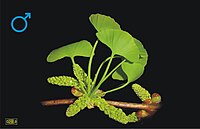
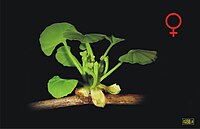
![Extinct Ginkgo yimaensis[43]](http://upload.wikimedia.org/wikipedia/commons/thumb/3/3f/Ginkgo_yimaensis.jpg/120px-Ginkgo_yimaensis.jpg)
![Extinct Ginkgo apodes[43]](http://upload.wikimedia.org/wikipedia/commons/thumb/a/a7/Ginkgo_apodes.jpg/120px-Ginkgo_apodes.jpg)
![Extinct Ginkgo adiantoides, or possibly a new taxon from the US, G. cranei[43]](http://upload.wikimedia.org/wikipedia/commons/thumb/a/a1/Ginkgo_adiantoides_-_G._cranii.jpg/120px-Ginkgo_adiantoides_-_G._cranii.jpg)
![Extant Ginkgo biloba[43]](http://upload.wikimedia.org/wikipedia/commons/thumb/b/b0/Ginkgo_biloba_%28new_form%29.jpg/120px-Ginkgo_biloba_%28new_form%29.jpg)


